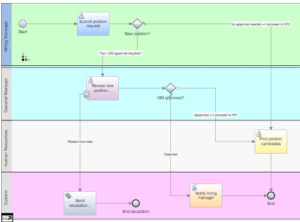
Ignite Your Business’s Potential: Unveiling the Competitive Edge of IBM BAW
- Posted by Peter George
- On October 25, 2023
“Why would I use your so-called solution: IBM BAW?”, “We’ll never be able to tailor your solution to our specific business requirements” and “Build me my own solution and save my time.”. These are the comments that are most likely to be stated once IBM Business Automation Workflow is mentioned to any stakeholder. However, is it meaningless to use IBM’s solution or is it truly improving and shifting any business’ bottom line?
Passing by Case Management and Business Process Management Solutions, IBM unveils their new Business Automation Workflows that stuns technical stakeholders with its capabilities and ability to transfer their businesses workflows to a whole new level of automations and ease to go miles away with their processes from where they stand now.
Let’s take a deep dive into the remarkable advantages that this innovative platform brings to your organization. Get ready to propel your business to new heights with IBM Business Automation Workflow—a pioneering solution that not only revolutionizes your processes but also empowers you with unparalleled efficiency, agility, and seamless workflow automation.
1. Streamlined Processes
IBM Business Automation Workflow (BAW) revolutionizes your business by optimizing and automating intricate and convoluted business processes. By doing so, it significantly reduces the need for manual effort, freeing up valuable time and resources. With its intuitive visual interface, BAW empowers you to effortlessly design, execute, and closely monitor workflows, ensuring seamless operations with enhanced efficiency.
2. Improved Agility
IBM Business Automation Workflow (BAW) enables organizations to swiftly adapt to changing business requirements and market dynamics. Here are some key aspects of BAW’s improved agility:
1- Rapid Process Modification: BAW’s flexible interface enables organizations to promptly modify workflows in response to changing business needs, regulations, or customer demands. This agility ensures alignment with business objectives without disruption to ongoing operations.
2- Dynamic Task Assignment: BAW enables dynamic task assignment based on various criteria such as workload, skills, availability, and priority.
3- Collaborative Workflows: BAW fosters collaboration and agility by supporting collaborative workflows, allowing employees, customers, and partners to actively participate and contribute. This collaborative approach enables real-time communication, feedback exchange, and iterative improvements, ensuring continuous refinement of workflows based on collective insights.
3- Seamless Integration
IBM Business Automation Workflow (BAW) excels in seamless integration with existing systems, applications, and databases, facilitating efficient data exchange and collaboration across the organization. Here are some examples of BAW’s seamless integration capabilities:
1- System Integration: BAW seamlessly integrates with various enterprise systems and applications, such as customer relationship management (CRM) systems, enterprise resource planning (ERP) systems, document management systems, core banking systems, and more. This integration allows for the seamless flow of data between different systems, eliminating the need for manual data entry, duplicate data storage or multiple platforms usage.
2- Service-Oriented Architecture (SOA): BAW also integrates with other services and systems using widely adopted protocols such as SOAP and REST. By embracing this approach, BAW optimizes efficiency and maximizes the utilization of resources while ensuring smooth integration with the broader IT ecosystem.
3- Data Exchange: BAW facilitates real-time data exchange between workflows and external systems, supporting standard formats like XML, JSON and web services. This ensures compatibility and seamless data transfer, granting workflows access to the latest and accurate information from connected systems.
4. Collaboration and Communication
IBM Business Automation Workflow (BAW) excels in promoting collaboration and communication among stakeholders involved in workflow processes making it easier for the flow to move and minimizing the human intervention and efforts for managing communication among different parties and teams concerned with the process. Here are further insights into the collaboration and communication capabilities of BAW:
1- Centralized Collaboration Platform: BAW acts as a centralized hub that facilitates collaboration and contribution from employees, customers, and managers in workflow processes. It provides a platform for communication, document sharing, and task management, creating an environment opportune to collaboration and teamwork.
2- Real-Time Communication: BAW facilitates instantaneous communication among participants involved in workflows. By integrating with diverse communication channels like email systems and instant messaging platforms, stakeholders can seamlessly exchange messages, updates, and notifications within the workflow context.
3- Task Assignment and Notifications: BAW enables task assignment and notifications triggering to ensure productive teamwork. Workflow activities can be delegated to particular people or groups, and notifications can be set off to alert stakeholders to updates, new tasks, or pending actions. This function simplifies the human task administration job and keeps everyone aware of their duties.
4- Audit Trail and History Tracking: BAW keeps track of interactions and process operations through an audit trail. This allows stakeholders to review the history of each workflow with all necessary data that might help them in monitoring the work.
5-Role-Based Access Control: BAW provides role-based access control to ensure appropriate access to each step of the flow to its only concerned team or employee, preserving data confidentiality and integrity.
5. Intelligent Automation
With the use of cutting-edge technologies like artificial intelligence (AI) and machine learning (ML), IBM Business Automation Workflow (BAW) integrates intelligent automation capabilities to improve workflow processes. Here are some significant features of the intelligent automation ascribe in BAW:
1-Robotic Process Automation (RPA): BAW integrates with RPA tools, permitting repetitive, rule-based processes to be automated. The seamless integration of RPA bots into BAW’s workflows allows for the completion of basic tasks while freeing up human resources for more demanding ones.
2- Machine Learning for Workflow Optimization: BAW uses ML algorithms to improve workflow procedures by continuously learning from prior data. It can automate decision-making based on learnt patterns, identify bottlenecks, and suggest process changes by analyzing patterns.
6. Monitoring and Analytics
The powerful monitoring and analytics capabilities offered by IBM Business Automation Workflow (BAW) enable businesses to better understand the performance of their workflows and promote ongoing process improvement. Here are further specifics on the Monitoring and Analytics characteristic of BAW:
1-Performance Metrics and Dashboards: BAW offers a variety of performance metrics and adjustable dashboards that give deep insight into how workflows are being carried out. To evaluate the effectiveness of the process, stakeholders can keep an eye on indicators like cycle time, throughput, resource utilization, and task completion rates.
2- Process Mining: Based on event logs feature previously mentioned, BAW uses process mining techniques to automatically find, visualize, and analyze workflows. Organizations can identify areas for improvement and optimization by using process mining to reveal hidden inefficiencies, variances, and deviations.
7. Cloud Deployment Options
Other than the well-known on-premises deployment option, BAW provides organizations with scalability, cost-effectiveness, and simple access to the workflow platform from anywhere through cloud deployment choices. Examples of those offered choices are as follows:
1- IBM Cloud Pak for Automation: BAW and other automation tools are part of the cloud-native platform known as IBM Cloud Pak for Automation. If you wish to benefit from the scalability and flexibility of the cloud, this option is a smart alternative.
2- Other public clouds: BAW can also be set up on various public clouds, like Microsoft Azure and Amazon Web Services (AWS). If you already have a deployment running on one of these clouds, this is a good alternative.
In summary, IBM Business Automation Workflow (BAW) presents a comprehensive solution with numerous benefits that can effectively support businesses across various industries.
Businesses seeking to streamline their operations and boost productivity will find it to be the best option thanks to its flexibility, scalability, and user-friendly interface. Organizations may easily navigate complicated operations, lower manual errors, and boost overall productivity by utilizing BAW. IBM BAW equips companies to adapt and grow in a dynamic and competitive environment with its extensive features and effortless integration skills. No matter the sector or size of the business, IBM BAW stands out as a reliable solution that paves the way for effective operations and results.





